2 认知语言学 English
英语认知语言学

英语认知语言学英语认知语言学是研究英语语言的认知过程和结构的学科领域。
它涉及到对英语的理解、产生和使用的认知机制和规律进行探究。
本文将从语音、词汇、语法和语义等方面来介绍英语认知语言学的研究内容和方法。
一、语音认知语音是语言的基本要素之一,语音的认知过程对于我们理解和使用语言至关重要。
在英语认知语言学中,研究者通过分析声音的特点、语音单位和发音过程来探究语音的认知机制。
其中,声音的特点指的是语言中的音素、音节和音调等音位学要素;语音单位则是指在理解和使用语言时所处于注意的最小单位,比如音素的串联等;而发音过程则是指人们在理解和使用语言时生成声音的过程,包括声带、发音器官的协调等。
二、词汇认知词汇是语言的基本单位,研究词汇的认知过程有助于我们理解词汇的构成和用法。
英语认知语言学关注词汇的存储、识别和产生等过程。
在存储方面,研究者通过研究一词多义、词义辨析和词汇关联等现象来揭示词汇存储的机制;在识别方面,研究者研究人们在理解语言时如何通过语境和词汇特征等信息进行词汇的识别;在产生方面,研究者关注人们在表达时如何选择和使用恰当的词汇。
三、语法认知语法是指语言的句法结构,研究语法的认知过程可以帮助我们理解句子的结构和组织方式。
在英语认知语言学中,研究者关注句法的生成、解析和回避等过程。
在生成方面,研究者研究人们如何按照一定的规则和模式生成符合语法的句子;在解析方面,研究者研究人们如何通过语法知识和上下文信息进行句子的解析;在回避方面,研究者研究人们在语言使用过程中如何避免语法错误和困惑。
四、语义认知语义是指语言的意义系统,研究语义的认知过程有助于我们理解语言的意义和表达方式。
英语认知语言学关注词义、句义和篇义等层面的研究。
在词义方面,研究者研究词汇的意义构成和扩展,探究词义的认知过程和规律;在句义方面,研究者关注句子的意义生成和解释过程,研究语义角色和语义关联等现象;在篇义方面,研究者研究文本和篇章的意义结构和组织方式。
论认知语言学在英语教学中的运用认知语言学的几大理论
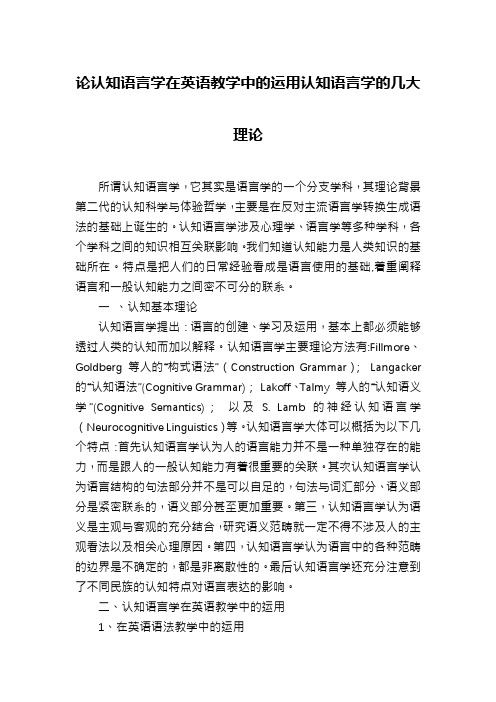
论认知语言学在英语教学中的运用认知语言学的几大理论所谓认知语言学,它其实是语言学的一个分支学科,其理论背景第二代的认知科学与体验哲学,主要是在反对主流语言学转换生成语法的基础上诞生的。
认知语言学涉及心理学、语言学等多种学科,各个学科之间的知识相互关联影响。
我们知道认知能力是人类知识的基础所在。
特点是把人们的日常经验看成是语言使用的基础,着重阐释语言和一般认知能力之间密不可分的联系。
一、认知基本理论认知语言学提出:语言的创建、学习及运用,基本上都必须能够透过人类的认知而加以解释。
认知语言学主要理论方法有:Fillmore、Goldberg 等人的“构式语法”(Construction Grammar);Langacker 的“认知语法”(Cognitive Grammar);Lakoff、Talmy 等人的“认知语义学”(Cognitive Semantics);以及S. Lamb 的神经认知语言学(Neurocognitive Linguistics)等。
认知语言学大体可以概括为以下几个特点:首先认知语言学认为人的语言能力并不是一种单独存在的能力,而是跟人的一般认知能力有着很重要的关联。
其次认知语言学认为语言结构的句法部分并不是可以自足的,句法与词汇部分、语义部分是紧密联系的,语义部分甚至更加重要。
第三,认知语言学认为语义是主观与客观的充分结合,研究语义范畴就一定不得不涉及人的主观看法以及相关心理原因。
第四,认知语言学认为语言中的各种范畴的边界是不确定的,都是非离散性的。
最后认知语言学还充分注意到了不同民族的认知特点对语言表达的影响。
二、认知语言学在英语教学中的运用1、在英语语法教学中的运用在传统的英语教学中,对学生的语法教学总是占据着主导地位。
一般而言,人们认为掌握语法是掌握语言的基础,而快捷的掌握语法的方法就是通过大量的英语课文阅读翻译。
这种教学法的主要忽视了学生的口语和听力训练,造成了学生口头交际能力较差;由于加大追求语法的准确性,从而某种程度上却忽略了学生的语言创造能力,使学生的语言学习的主观能动性不能充分展露出来,这很不利于良好的英语教学的进展。
认知语言学课件

2 .2Judgment (判断) / Comparison (对比) The construal operations of judgment / comparison have to do with judging something by comparing it to something else.判断/对比识解操作 与把一物比作另一物的判断相关.它是人类基本的认 识能力,也是人类经验的基础.
For example: the structure of an apple, an individual’ s perceptual sphere, an individual’ s social sphere, with family and friends at the core and others at the outside.
其 特 征 体 现 在 以 下 四 个 方 面 ( Croft and cruse) : 1 上位范畴没有基本层次范畴好,尽管它的成员可以区别于邻 近的范畴,但是范畴内的相似性相对比较低。 2 上位范畴比基本层次范畴的定义特征是少。 3 基本层次范畴的中间层次上位范畴之间有单一的修饰关系。 4 从语言学的角度说,上位范畴的名词大多是物质名词,而基 本层次范畴的名词是可数名词。
13
3 .3Subordinate level附属层次范畴 At this level we perceive the differences between the members of the basic level categories. Often the names for SUBORDINATE LEVEL categories are morphologically complex. They are typically composite forms. One such example is that of compound nouns.
认知语言学

认知语言学
一、引言
在语言学领域中,认知语言学是一门研究人类语言认知过程的分支学科。
通过研究人类认知系统如何处理和理解语言,认知语言学试图探寻语言习得、语言使用以及语言理解背后的认知机制。
本文将深入探讨认知语言学的基本概念、研究方法和相关实践应用。
二、认知语言学的基本概念
认知语言学是一种结合了心理学、语言学和计算机科学的跨学科研究领域。
它关注如何人类的认知系统利用符号系统来组织和理解语言,探究语言如何影响人类思维和表达方式。
认知语言学强调个体在语言过程中的认知能力和处理方式,从而揭示语言和思维之间的密切联系。
三、认知语言学的研究方法
认知语言学采用多种研究方法来探究语言认知过程。
其中,实验研究是认知语言学的主要方法之一,通过实验设计和数据分析,揭示出不同语言任务对认知系统的影响。
另外,神经科学方法、计算模型和语料库分析等也被广泛运用于认知语言学研究中,从不同角度揭示语言处理的认知机制。
四、认知语言学的实践应用
认知语言学的研究成果对语言教学、心理治疗和人机交互等领域具有广泛的应用前景。
通过理解语言认知机制,我们可以改进教学方法,提高语言学习效率;或者通过干预认知过程,帮助患有语言障碍的个体进行康复治疗;同时,认知语言学还为智能机器人和人工智能技术的发展提供了重要的理论支持。
五、结论
认知语言学作为语言学研究中的重要分支,不仅为理解人类语言认知过程提供了新的视角,也为应用性领域的发展带来了新的机遇。
通过深入研究语言和认知之间的关系,认知语言学将继续推动语言学领域的发展,并为人类认知研究带来新的启示。
认知语言学解读
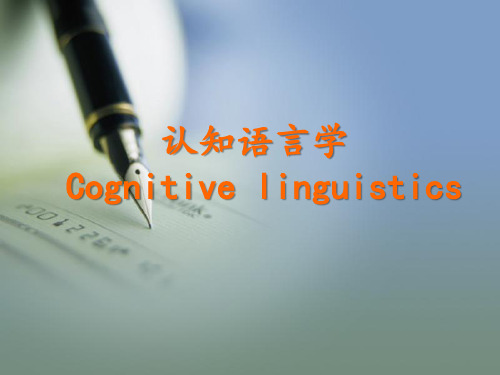
• 戴浩一:台湾国立中正大学语言学研究所教授, 是少数专长于认知语言学的华人。
• 王士元:香港中文大学现代语言学系暨中研院院 士,另一少数专长于认知语言学的华人。
二、认知语言学的主要概念
• 原型 • 范畴化、基本范畴 • 上下位 • 隐喻模式、转喻模式
孕育,80年代中期以后开始成熟。1987年,美国
莱考夫《范畴》的出版,标志着认知语言学的形
成;1989年,勒内·德尔文组织的在德国杜伊斯堡
召开的第一届国际认知语言学大会标志着认知语
言学的正式诞生。90年代中期以后,认知语言学
开始进入稳步发展阶段。
• 认知语言学代表人物
• 乔治·雷可夫 (George P. Lakoff1941年-):认知语言 学的其中一位创立者,提倡比喻(隐喻)是日常语言 活动中的必须认知能力。
• 2.范畴化:
范畴化,也叫做归类,是比较的一个特例。 一个范畴或类别往往有个“原型”,是用以确定 类别的参照标准,需要归类的目标与标准进行比 较,符合标准所有特征的目标例示这一标准,不 完全符合的目标是对标准的扩展。
范畴化,简单地说,就是把不同的事物归为同 一类型的过程。例如:人有各种各样的人,我们把 不同的人统称为“人”,这就是一种范畴化。
认知语言学 Cognitive linguistics
目录
一、什么是认知语言学(定义、 背景、代表人物)
二、认知语言学的主要概念 三、思考探究 四、认知语言学的优与缺 五、认知语言学在中国
一、什么是认知语言学
•
认知语言学是语言学的一门分支学科,它在
反对主流语言学转换生成语法的基础上诞生,在
认知语言学
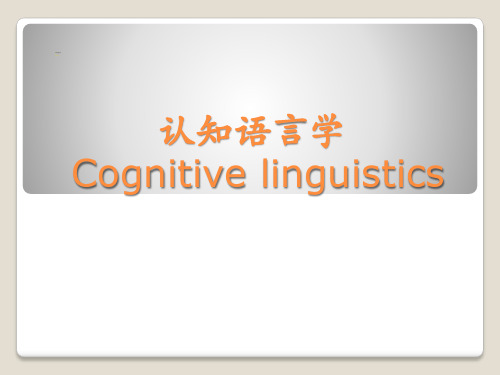
学科发展历程
认知语言学在20世纪70年代中期开始在美国孕育(朗 奴·兰盖克提出空间语法),80年代中期以后开始成熟, 其学派地位得以确立,其确立标志为1989年春由勒内·德 尔文(ReneDirven) 组织的在德国杜伊斯堡(Duisbury) 召 开的第一届国际认知语言学大会。此次大会宣布于1990年 发行《认知语言学》杂志, 成立国际认知语言学( ICLA) , 出版认知语言学研究的系列专著,90年代中期以后开始进 入稳步个特例。一个范 畴或类别往往有个“原型”,是用以确定类别的参照标准, 需要归类的目标与标准进行比较,符合标准所有特征的目 标例示(instantiate)这一标准,不完全符合的目标是 对标准的扩展(extension)。
经典范畴理论的如下特征 1 范畴划分由一组充分必 要条件决定 2 特征是二元 3 范畴具有清晰边界 4 范畴 成员之间地位平等。
eg2.钟书能 阮薇. 认知与忠实——汉英上下位词翻译的认知 视角『j』.韶关学院学报
3.上下位:
以基本层次范畴为中心 范畴可以向上发展为上位范畴向 下发展为下位范畴上位范畴依赖于基本层次范畴 且物体 的完形形象和大部分属性都来自基本层次范畴 因此又被 称为寄生范畴(parasiticcategory) 下位范畴也是寄生范 畴它是在基本层次范畴的基础上更进一步细致的切分。
二、认知语言学的主要概念
原型 范畴化、基本范畴、上下位 命题模式、意象模式、隐喻模式、转喻模式 意象图示
1.原型(prototype):
是物体范畴最好、最 典型的成员, 所有其他成 员也均具有不同程度的典 型性。
eg1. 在英语的世界图景中, 鸟的原型为画眉鸟;而对于 母语为俄语的人而言则是 麻雀; 麻雀在中国人的认 知意义中也具有典型意义。
语言学常用术语英汉对照表

语言学常用术语英汉对照表语言学常用术语英汉对照表Chapter 1 Introduction to Ling uistics语言学简介1、anthropological linguistics 人类语言学2、applied linguistics应用语言学3、arbitrariness任意性4、petence 语言能力5、putational linguistics计算机语言学6、cultural transmission 文化传递性7、descriptive(grammar) 描写(语法)8、descriptive function描写功能9、design features识别特征10、diachronic linguistics历时语言学11、duality二重性12、displacement不受时空限制得特征13、emotive function表情功能14、expressivefunction表达功能15、general linguisitcs 普通语言学16、ideational function概念功能17、interpersonal function人际功能18、langue语言19、linguistics [li?'gwistiks] 语言学20、morphology 形态学21、mathematical linguistics 数理语言学22、metalinguistic function23、neurologicallinguistics 神经语言学24、phonetics语音学25、phonology 音系学26、pragmatics 语用学27、prescriptive(grammar)规定(语法) 28、psycholinguistics心理语言学29、parole言语30、performance语言运用31、productivity能产性32、poetic function诗学功能33、phatic munion 交感性谈话34、referential function所指功能35、semantics语义学36、social function社会功能37、socio-linguistics 社会语言学38、synchroniclinguistics共时语言学39、syntax句法学40、textual function语篇功能41、Traditional Grammar传统语法Chapter 2 Phonology 音系学1、acousticphonetics声学语音学2、articulatory phonetics发音语音学3、affricate破擦音4、allophone音位变体5、alveolar齿龈音6、auditory phonetics听觉语音学7、aspiration送气8、assimilationrules同化现象9、back vowel后元音10、bilabial双唇音11、broad transcription宽式音标12、central vowel中元音13、close vowel闭元音14、plementarydistribution互补分布15、deletion rules省略规则16、dental齿音17、diphthong双元音18、fricative摩擦音19、front vowel前元音20、glide滑音21、glottal声门音22、hard palate硬腭23、InternationalPhonetics Alphabet国际音标24、intonation语调25、labiodental唇齿音26、liquid流音27、manner ofarticulation发音方式28、minimal pair 最小对立体29、minimalset最小对立组30、monophthong单元音31、narrow transcription严式音标32、nasal鼻音33、nasalcavity鼻腔34、open vowel开元音35、oral cavity口腔36、palatal硬腭37、pharyngealcavity咽腔38、place of articulation发音部位39、phone因素40、phoneme音素41、phonemic contrast音位对立42、rounded vowel元唇元音43、semi-close vowel半闭元音44、semi-openvowel半开元音45、sequential rules序列规则46、segment切分成分47、segmentation切分48、soft palate软腭49、stop塞音50、stress重音51、suprasegmentalfeatures超切分特征52、teeth ridge齿龈53、tone声调54、unrounded vowel非圆唇元音55、uvula小舌56、velar软腭音57、velum软腭58、voicing浊音化Chapter 3 Morphology 形态学1、affix词缀2、allomorph语素变体3、base词基4、bound morpheme黏着语素5、lexicon词汇6、closed classwords封闭词类7、pound words 合成词8、derivation派生;派生过程9、derivational morphem派生语素10、free morpheme自由语素11、inflectionalmorpheme屈折语素12、infinitive marker不定式标记13、morph形素14、morphological rules形态规则15、open classwords开放词类16、root词根17、stem词干Chapter 4Syntax 句法学1、auxiliary助动词2、category范畴3、plement补足语;补充成分4、plement clause补足分句5、coordinationrule并列规则6、coordinate structure并列结构7、deep structure深层结构8、determiner限定词9、head中心词10、head movement中心词移位11、insertion插入12、inversion倒装13、majorlexical categories主要词汇范畴14、matrix clause主句15、minor lexical categories次要词汇范畴16、phrase structure短语结构17、modifier修饰成分18、qualifier后置修饰成分19、specifier标志语20、subcategorization次范畴化21、surface structure表层结构22、syntactic category句法范畴23、trace语迹24、transformation转换Chapter5Semantics语义学1、antonymy反义现象2、argument谓元;变元3、behaviorism行为主义4、co-hyponym并列下义词5、collocationalsynonym搭配同义词6、plementaryantonym互补反义词7、pletehomonym完全同形异义词8、ponential analysis成分分析9、conceptualist view概念论10、contextualism语境主义11、contradition自相矛盾得说法12、dialectal synonym方言同义词13、emotive meaning情感意义14、entailment蕴含15、evaluative meaning评价意义16、gradable antonym层级反义词17、homograph同形异义词18、homonymy同音同形异义关系19、homophone同音异义词20、hyponym下义词21、hyponymy下义关系22、inconsistency自相矛盾23、polysemy多义关系24、polysymous word多义词25、presupposition预设26、predication analysis述谓分析27、predicate谓词28、namingtheory命名论29、no-place predicaiton空位述谓解耦股30、one-placepredication一位述谓结构31、reference(所指)语义32、referent所指物;所指对象33、relational opposite关系反义词34、semantic triangle语义三角35、sense意义36、stylistic synonym语体同义词37、superordinate上坐标词38、symbol符号39、synonym同义词40、synonymy同义关系41、two-place predicaiton二位述谓结构42、three-place predication三位述谓结构Chapter6 Pragmatics语用学1、missives承诺类2、CooperativePrinciple合作原则3、constatives述事话语4、context语境5、conventional implicature规约含义6、declarations宣告类7、directives指令类8、expressives表情类9、illocutionaryact言外功能10、illocutionary point言外之得11、implicature蕴含;含义;会话含义;言外之意12、indirectspeech act间接言语行为13、locutionary act言内行为14、maximofrelation关系准则15、maximof manner方式准则16、maxim of quality质准则17、maximofquantity量准则18、particularized conversational implicature特殊会话含义19、perfomatives行事话语20、perlocutionaryact言后行为21、presupposition前提22、primaryspeechact 主要言语行为23、representatives表述类24、secondary speechact次要言语行为25、sentence meaning句子意义26、speechacttheory言语行为理论27、utterance meaning话语意义Chapter 7 LanguageChange语言变化1、acronyms词首字母缩略词2、back-formation 逆成法3、blending混成法4、borrowing借词5、clipped words截略词6、coinage创新词7、functionalshift功能性变化8、historical linguistics历史语言学9、MiddleEnglish中世纪英语10、Modern English现代英语11、morphologicalchange形态变化12、negation rule否定规则13、Old English古英语14、phonological change音位变化15、semantic change语义变化16、semanticshift语义转移17、syntactic change句法变化Chapter 8 Languageand society语言与社会1、bilingualism双语制2、Black English黑人英语3、creole克里奥尔语4、diglossia双语;双言制5、ethnic dialect种族变体6、field of discourse语场7、gender性别8、idiolect个人变体9、mode ofdiscourse语式10、multilingualism多语制11、pidgin洋泾浜语12、regionaldialect地域方言13、register语域14、sociolect社会变体15、speechmunity言语社团16、speech variety言语变体17、tenor of discourse语旨Chapter 9Language andculture语言与社会1、acculturation 同化过程2、amalgamation混合3、assimilation同化(现象);同化(作用)4、connotativemeaning内涵意义5、colour words颜色词6、culturaloverlap文化重叠7、culturalimperialism文化帝国主义8、denotative meaning外延意义9、linguistic relativity语言相对性10、metaphor隐喻11、Sapir-Whorf Hypothesis萨丕尔——沃尔夫假说12、socialization社会化13、taboo禁忌语14、intercultural munication跨文化交际15、linguisticimperialism语言学中得帝国主义16、linguisticnationalism语言学中得民族主义Chapter 10 Language acquisition语言习得1、aphasia失语症2、behaviorist 行为主义者3、caretaker talk保姆式语言4、cognitivelinguistics认知语言学5、content word实词6、Critical PeriodHypothesis临界期假说7、dysgraphia书写困难8、dyslexia失读症9、feedback反馈10、function element起功能作用成分11、hearing impairment听力受损12、innatist语法天生主义者13、interactionist互动主义者14、LanguageAcquisition Device语言习得机制15、lexicalcontrast词汇对比16、mental retardation智障17、motherese保姆式语言18、over-extension过度扩展19、prototype theory原型理论20、recast修正性重复21、stuttering口吃22、telegraphic speech电报式言语23、under-extension扩展不足24、Universal Grammar普遍语法Chapter 11Second languageacquisition第二语言习得1、affect/social strategies社会策略2、ageofacquisition习得年龄3、cognitivestrategies认知策略4、prehensibleinput可理解性输入5、Constrastive Analysis对比分析6、cross-association互相联想7、Error Analysis错误分析8、foreign language外语9、foreigner talk外国人谈话10、fossilization语言石化(现象)11、Input Hypothesis输入假说12、instrumental motivation工具动机13、intake 纳入14、integrativemotivation综合动机15、interference干扰16、interlanguage中介语17、interlingual errors语际错误;受母语影响得错误18、Intralingual error语内错误19、intrinsic motivation内在动机20、intuition知觉;语感21、learnerlanguage学习者语言22、learning strategies学习策略23、language aptitude语言能力24、languagetransfer语言迁移25、metacognitive strategies元认知策略26、motivation动机27、modified input修改后得输入28、modified interaction变化性得互动29、negative transfer消极迁移;负迁移30、overgeneralization概括过头31、personality人格;性格;个性32、positive transfer积极迁移;正迁移33、resultativemotivation结果动机34、secondlanguage第二语言35、secondlanguage acquisition第二语言习得36、teacher talk教师谈话37、target language目标语Chapter 12Language and the brain 语言与大脑1、acquired dysgraphia习得性书写障碍2、acquired dyslexia习得性失读症3、angular gyrus隅骨4、autopsy studies尸检研究5、brain stem脑干6、Broca’s aphasia布罗卡失语症7、Broca’s area布罗卡区8、bottom-up processing自下而上处理过程cerebrum大脑9、central sulcus中央沟10、cerebellum小脑脑向背侧突出得一个较大得部分,尤与肌肉得共济运动与维持身体平衡有关11、cerebral hemisphere大脑半球12、cohort model交股模型13、putarized Axial Tomography计算机化轴向层面X射线摄影法14、corpus(语言)素材15、corpuscallosum胼胝体16、cortex大脑皮层17、deep dyslexia深层诵读困难18、Dichotic listening studies双耳分听实验19、event-related potential experiment20、eye movementexperiment眼动实验21、fissure裂缝;裂隙22、fluent aphasia流利性失语症23、frontal lobe额叶(大脑半球得前部,其下部位于颅前窝,后界中央沟24、Functional MRI功能磁共振成像25、garden path sentence花园路径句26、global aphasia整体性失语症27、gyrus回28、hierarchical structure层级结构29、late closure principle后封闭原则;晚封闭原则30、lateral fissure侧脑裂31、lateralization侧化32、lesion损害33、lexicaldecision词汇判断;词汇确定法34、lobes叶,身体器官得由表面得沟裂分出得部分35、longitudinalfissure纵裂36、MagneticResonance Imaging磁共振成像37、neuron神经细胞,神经元38、minimalattachment principle最低限度结合原则39、module模块;组块40、non-fluent aphasia失语症41、occipital lobe枕叶大脑半球得后叶,呈三面得锥形, 与前方得顶叶与下方得颞叶没有明显得界限42、parietal lobe顶叶Positron emission Tomogra phy正电子发射X射线层析照相术;计算机辅助正电子发射断层扫描技术43、phologicaldyslexia拼音性失读症44、priming启动45、priming effect启动效应46、priming experiment启动实验47、right earadvantage右耳优势;右耳听力强48、selectional restriction选择限制49、sentenceambiguity句子歧义50、“Sodium Amystal“Test阿米妥纳实验Spoone rism斯本内现象51、splitbrain studies裂脑研究52、sulcus沟53、surface dyslexia浅层诵读困难54、syntactic parser句法处理器55、temporallobe颞叶56、timed-reading experiment限时阅读实验57、top-down processing自上而下处理过程58、Wernicke’s aphasia韦尼克失语症。
认知语言学
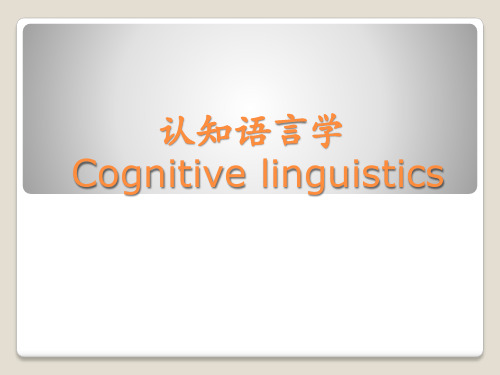
认知语言学代表人物及代表作
乔治·雷可夫 (George P. Lakoff;/ˈleɪˌkɔf/,1941年-):认知语言 学的其中一位创立者,提倡比喻(隐喻)是日常语言活动中的必须认知能 力。
马克·詹森 (Mark Johnson:
朗奴·兰盖克 (Ronald Langacker,1942年12月27日-):认知文法的提 倡者
eg2.钟书能 阮薇. 认知与忠实——汉英上下位词翻译的认知 视角『j』.韶关学院学报
3.上下位:
以基本层次范畴为中心 范畴可以向上发展为上位范畴向 下发展为下位范畴上位范畴依赖于基本层次范畴 且物体 的完形形象和大部分属性都来自基本层次范畴 因此又被 称为寄生范畴(parasiticcategory) 下位范畴也是寄生范 畴它是在基本层次范畴的基础上更进一步细致的切分。
Gilles Fauconnier (1944年8月19日-)
Charles J. Fillmore
William Croft Michael Tomasello (1950年1月18日-)
戴浩一:台湾国立中正大学语言学研究所教授,是少数专长于认知语言 学的华人。
王士元:香港中文大学现代语言学系暨中研院院士,另一少数专长于认 知语言学的华人。
认知语言学 Cognitive linguistics
一、什么是认知语言学 二、认知语言学的主要概念 三、认知语法学 四、认知语言学的研究方法 五、认知语言学优与缺 六、认知语言学在中国
一、什么是认知语言学
认知语言学是语言学的一门分支学科它脱胎自认知心理 学或认知科学,大约在1980年代后期至1990年代开始成型。 认知语言学涉及电脑自然语言理解、人工智能、语言学、 心理学、系统论等多种学科,它针对当时仍很火热的生成 语言学,提出:语言的创建、学习及运用,从基本上都必 须能够透过人类的认知而加以解释,因为认知能力是人类
认知语言学英语作文

认知语言学英语作文英文:Cognitive linguistics is a fascinating field that explores the relationship between language and the human mind. It examines how our mental processes shape and are shaped by language, and how language in turn influences our cognition. As a student of cognitive linguistics, I have come to appreciate the intricate ways in which language reflects and influences our thought patterns.One interesting aspect of cognitive linguistics is the concept of linguistic relativity, or the idea that the structure of a language can affect the way its speakers perceive and think about the world. For example, the famous Sapir-Whorf hypothesis suggests that the language we speak can influence our perception of reality. A classic example of this is the Inuit people having multiple words for "snow," reflecting their deep understanding and categorization of different types of snow. This shows howlanguage can shape our perception and understanding of the world around us.Another intriguing concept in cognitive linguistics is the role of metaphor in language and thought. Metaphors are not just literary devices, but are deeply ingrained in the way we conceptualize and understand the world. For instance, we often talk about time as if it's a physical object that we can save, waste, or spend. This metaphorical understanding of time shapes the way we think about andtalk about it.中文:认知语言学是一个迷人的领域,它探讨了语言和人类思维之间的关系。
英语学习中的认知语言学研究

英语学习中的认知语言学研究随着全球化的发展,越来越多的人开始学习英语,但是学习英语并不是一件简单的事情,很多人都会遇到各种各样的问题,例如听力不好、语法错误等。
在这种情况下,认知语言学的研究为我们提供了一个新的视角,有助于我们更深入地了解英语学习的过程。
因此,本文将探讨英语学习中的认知语言学研究,包括它的定义、重要性以及在英语学习中的应用。
什么是认知语言学?认知语言学是指研究语言与思维之间的关系的学科,它探讨自然语言的结构、语义、规则和知觉等方面的问题。
与传统的语言研究不同,认知语言学强调语言和思维之间的相互作用,认为语言是人类认知能力的一部分。
因此,它的研究对象和方法都比较复杂,需要跨学科的研究和多种方法的综合应用。
为什么认知语言学对英语学习很重要?认知语言学的研究对英语学习有很多启示。
首先,它能够帮助我们更好地理解语言的规则和结构。
对于英语学习者来说,语法规则和句子结构是学习过程中最关键的部分。
如果我们能够深入探讨这些问题,我们就能够更加准确地理解英语语言的本质,并且能够更好地运用它。
其次,认知语言学的研究可以帮助我们更好地理解语言的语义。
英语是一门具有多义和抽象性质的语言,这意味着学习者必须理解词汇和语境之间的关系,以及词语的义项等。
认知语言学从认知角度出发,探讨语义的本质,从而让我们更深入地了解英语单词和句子的意义和用法。
最后,认知语言学的研究可以帮助我们更好地把握语言的发音和韵律。
英语是一门具有强烈音韵感的语言,在发音和韵律方面也有着很高的要求。
通过认知语言学的研究,我们可以了解英语中的声调和重音等元素,从而更好地掌握英语的发音和语调。
英语学习中的应用在英语学习中,认知语言学的研究可以应用于多个方面。
首先,它可以帮助我们更好地把握英语语法和语义规则。
例如,在学习英语的过程中,我们可以根据句子结构和语义分析句子的意义,从而更好地掌握英语的用法和表达方式。
此外,我们也可以通过学习语言和思维的关系,提高自己的语言思维和表达能力。
认知语言学英语作文范文
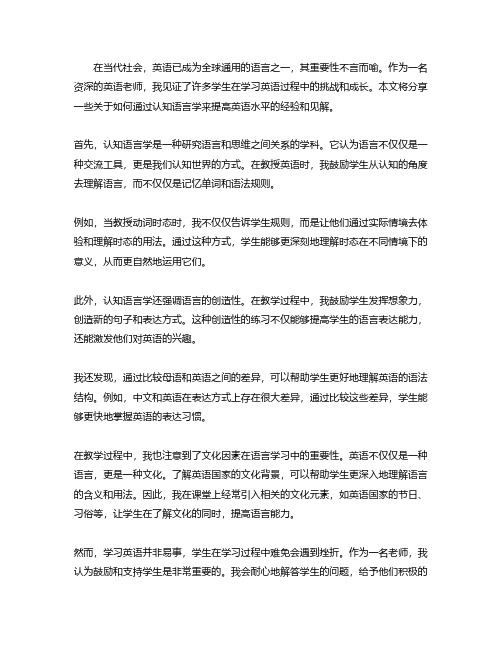
在当代社会,英语已成为全球通用的语言之一,其重要性不言而喻。
作为一名资深的英语老师,我见证了许多学生在学习英语过程中的挑战和成长。
本文将分享一些关于如何通过认知语言学来提高英语水平的经验和见解。
首先,认知语言学是一种研究语言和思维之间关系的学科。
它认为语言不仅仅是一种交流工具,更是我们认知世界的方式。
在教授英语时,我鼓励学生从认知的角度去理解语言,而不仅仅是记忆单词和语法规则。
例如,当教授动词时态时,我不仅仅告诉学生规则,而是让他们通过实际情境去体验和理解时态的用法。
通过这种方式,学生能够更深刻地理解时态在不同情境下的意义,从而更自然地运用它们。
此外,认知语言学还强调语言的创造性。
在教学过程中,我鼓励学生发挥想象力,创造新的句子和表达方式。
这种创造性的练习不仅能够提高学生的语言表达能力,还能激发他们对英语的兴趣。
我还发现,通过比较母语和英语之间的差异,可以帮助学生更好地理解英语的语法结构。
例如,中文和英语在表达方式上存在很大差异,通过比较这些差异,学生能够更快地掌握英语的表达习惯。
在教学过程中,我也注意到了文化因素在语言学习中的重要性。
英语不仅仅是一种语言,更是一种文化。
了解英语国家的文化背景,可以帮助学生更深入地理解语言的含义和用法。
因此,我在课堂上经常引入相关的文化元素,如英语国家的节日、习俗等,让学生在了解文化的同时,提高语言能力。
然而,学习英语并非易事,学生在学习过程中难免会遇到挫折。
作为一名老师,我认为鼓励和支持学生是非常重要的。
我会耐心地解答学生的问题,给予他们积极的反馈,帮助他们建立自信心。
总之,通过认知语言学的方法,我们可以更有效地帮助学生学习英语。
这不仅需要老师的努力,也需要学生的积极参与和创造性思维。
我相信,只要我们用心去教,用心去学,每个人都能够掌握这门美丽的语言。
《认知语言学》PPT课件

• 一般来说,认知语言学分为两大领域,其一为 “认知语法”,其二为“认知语义学”。
•认 知 语 法 的 奠 基 人 和 代 表 人 物 为 Ronald Langacker(San Diego),认知语义学的 奠基人为 George Lakoff(Berkeley)。两人均为加 州大学的学者,为此有人说认知语言学与生成 语言学的争论,是美国东西海岸之争(生成语法 理论的核心人物乔姆斯基在麻省理工学院)。
认知语言学的基本研究框架
(1)语言研究必须同人的概念形成过程的研究联系 起来。
(2)词义的确立必须参照百科全书般的概念内容和 人对这一内容的解释(construal)。
( 3 ) 概 念 形 成 根 植 于 普 遍 的 躯 体 经 验 ( bodily experience),特别是空间经验,这一经验制约了人 对心理世界的隐喻性建构。
• 另有一种说法, 将1987年视作认知语言学的 正式诞生年, 因为这一年出版了认知语言学 的两部奠基之作: 一部是莱考夫的《女人、 火和危险事物———范畴揭示了思维的什 么奥秘》。此书由芝加哥大学出版社出版, 后又多次再版。该书一问世, 马上轰动了美 国的科学界, 许多重要的学术刊物纷纷发表 评论; 另一部是兰盖克的《认知语法基础》 ( 第一卷) 。
• 2、对语言范畴化诸原则的研究。
• 原型是物体范畴最好、最典型的成员, 所有其 他成员也均具有不同程度的典型性。比如说, 在英语的世界图景中, 鸟的原型为画眉鸟;而对 于母语为俄语的人而言则是麻雀; 麻雀在中国 人的认知意义中也具有典型意义。
• 根据莱考夫的论述, 认知模式据其结构原则的 不同分为四种: 命题模式、意象图示模式、隐 喻模式和转喻模式。
什么是认知语言学认知语言学的原则
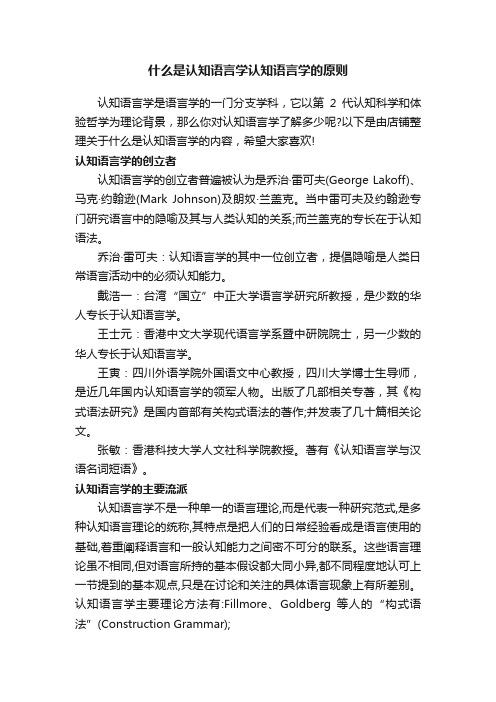
什么是认知语言学认知语言学的原则认知语言学是语言学的一门分支学科,它以第2代认知科学和体验哲学为理论背景,那么你对认知语言学了解多少呢?以下是由店铺整理关于什么是认知语言学的内容,希望大家喜欢!认知语言学的创立者认知语言学的创立者普遍被认为是乔治·雷可夫(George Lakoff)、马克·约翰逊(Mark Johnson)及朗奴·兰盖克。
当中雷可夫及约翰逊专门研究语言中的隐喻及其与人类认知的关系;而兰盖克的专长在于认知语法。
乔治·雷可夫:认知语言学的其中一位创立者,提倡隐喻是人类日常语言活动中的必须认知能力。
戴浩一:台湾“国立”中正大学语言学研究所教授,是少数的华人专长于认知语言学。
王士元:香港中文大学现代语言学系暨中研院院士,另一少数的华人专长于认知语言学。
王寅:四川外语学院外国语文中心教授,四川大学博士生导师,是近几年国内认知语言学的领军人物。
出版了几部相关专著,其《构式语法研究》是国内首部有关构式语法的著作;并发表了几十篇相关论文。
张敏:香港科技大学人文社科学院教授。
著有《认知语言学与汉语名词短语》。
认知语言学的主要流派认知语言学不是一种单一的语言理论,而是代表一种研究范式,是多种认知语言理论的统称,其特点是把人们的日常经验看成是语言使用的基础,着重阐释语言和一般认知能力之间密不可分的联系。
这些语言理论虽不相同,但对语言所持的基本假设都大同小异,都不同程度地认可上一节提到的基本观点,只是在讨论和关注的具体语言现象上有所差别。
认知语言学主要理论方法有:Fillmore、Goldberg 等人的“构式语法”(Const ruction Grammar);Langacker 的“认知语法”(Cognitive Grammar);Lakoff、Talmy 等人的“认知语义学”(Cognitive Semantics);以及S. Lamb 的神经"认知语言学"(Neurocognitive Linguistics)等。
认知语言学英语作文
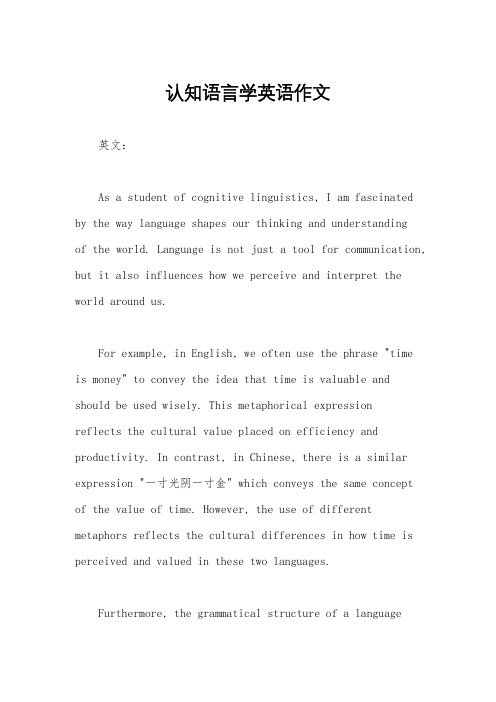
认知语言学英语作文英文:As a student of cognitive linguistics, I am fascinated by the way language shapes our thinking and understandingof the world. Language is not just a tool for communication, but it also influences how we perceive and interpret the world around us.For example, in English, we often use the phrase "timeis money" to convey the idea that time is valuable and should be used wisely. This metaphorical expressionreflects the cultural value placed on efficiency and productivity. In contrast, in Chinese, there is a similar expression "一寸光阴一寸金" which conveys the same conceptof the value of time. However, the use of different metaphors reflects the cultural differences in how time is perceived and valued in these two languages.Furthermore, the grammatical structure of a languagecan also shape our thinking. For instance, in English, we use the passive voice to focus on the action rather than the doer of the action. This can lead to a different emphasis and interpretation of events compared to languages that do not use the passive voice as frequently. 。
认知语言学

• 认知语言学代表人物
• 乔治· 雷可夫 (George P. Lakoff1941年-):认知语言 学的其中一位创立者,提倡比喻(隐喻)是日常语言 活动中的必须认知能力。 • 朗奴· 兰盖克 (Ronald Langacker,1942年12月27日-): 认知文法的提倡者。 • 戴浩一:台湾国立中正大学语言学研究所教授, 是少数专长于认知语言学的华人。 • 王士元:香港中文大学现代语言学系暨中研院院 士,另一少数专长于认知语言学的华人。
• 3.上下位:
以基本层次范畴为中心,范畴可向上发展为 上位,范畴向下发展为下位。
例如:Agriculture is the foundation of the national economy, We must follow the principle of combining。(农业是国民经济的 基础,我们要坚持农林牧副渔相结合的方针) 分析:第一个“农业”指的是农业经济,具 有广泛意义,因此译“agriculture”;第二个 “农业”具有专指意义,所以要译成下位词 “farming”,才能准确地表达原意。
二、认知语言学的主要概念
• 原型 • 范畴化、基本范畴 • 上下位 • 隐喻模式、转喻模式
• 1.原型(prototype):
原型范畴理论是认知语言学提出的重要观点 , 其哲学根源基于 “家族相似性 ”。它是物体范 畴最好、最典型的成员, 而其他成员有的典型性 显著,有的具有非典型性、处于范畴的边缘位置。 如:在“鸟”这个范畴中,知更鸟是最典型 的成员,因为它具有这个范畴的所有特性。而鸵 鸟、企鹅、蝙蝠则处于“鸟”的范畴的边缘位置, 它们和知更鸟共有的特性非常少。
• 四、认知语言学优与缺
• 1.优点
• • • • 提供自然的、符合人们语感的分析 注重概念化对语法的影响 对语言的共性和历史的成功解释 常利用图解的办法,准确而简明地把一个复杂的语 法范畴系统表达出来 • 洞察跨词类之间的共性 • 把动态的认知过程引入语法分析 • 确立语义和句法之间的“一对一”映射关系
认知语言学英语作文
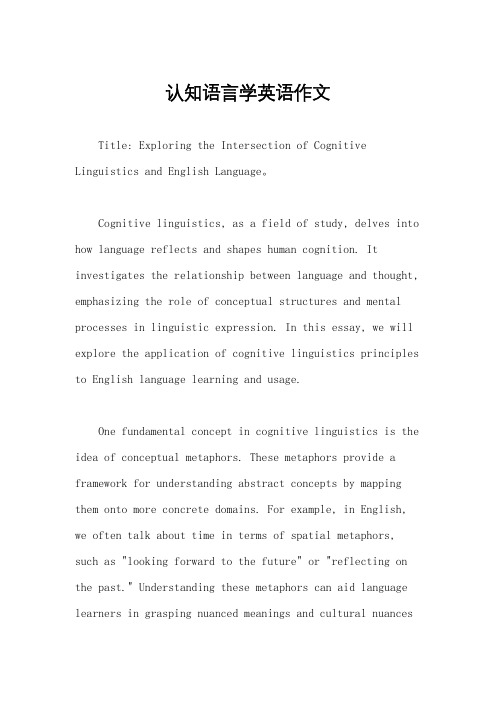
认知语言学英语作文Title: Exploring the Intersection of Cognitive Linguistics and English Language。
Cognitive linguistics, as a field of study, delves into how language reflects and shapes human cognition. It investigates the relationship between language and thought, emphasizing the role of conceptual structures and mental processes in linguistic expression. In this essay, we will explore the application of cognitive linguistics principles to English language learning and usage.One fundamental concept in cognitive linguistics is the idea of conceptual metaphors. These metaphors provide a framework for understanding abstract concepts by mapping them onto more concrete domains. For example, in English, we often talk about time in terms of spatial metaphors, such as "looking forward to the future" or "reflecting on the past." Understanding these metaphors can aid language learners in grasping nuanced meanings and cultural nuancesembedded in language use.Another aspect of cognitive linguistics relevant to English language learning is the notion of linguistic relativity, also known as the Sapir-Whorf hypothesis. This hypothesis suggests that the structure of a language influences its speakers' perception and cognition. While the strong version of this hypothesis, claiming that language determines thought, has been largely discredited, there is evidence supporting the idea that language can influence certain cognitive processes. For instance, languages with grammatical gender, like Spanish or French, may influence speakers' perceptions of objects based on their gender assignment.Moreover, cognitive linguistics offers insights into the way language is embodied, meaning that linguistic structures often reflect bodily experiences and sensory perceptions. For English language learners, understanding this embodiment can enhance their comprehension and production of language. For instance, verbs like "grasp," "reach," or "understand" evoke physical actions,highlighting the embodied nature of language.Furthermore, cognitive linguistics emphasizes the role of cultural schemas and conceptual frames in shaping language use. These mental structures influence how speakers interpret and produce language in different contexts. For example, the cultural frame of politeness guides English speakers in choosing appropriate forms of address and expressions of gratitude. By understanding these cultural schemas, language learners can navigate social interactions more effectively.Additionally, cognitive linguistics offers valuable insights into the role of prototypes and categorization in language learning and usage. Concepts in language are often organized around prototype examples, which represent the most typical or central instances of a category. Understanding prototypes can aid language learners in forming categories and making sense of new vocabulary. For example, when learning English adjectives, learners often encounter prototype examples like "big" or "beautiful," which serve as anchors for understanding related terms.Incorporating cognitive linguistics principles into English language teaching can enrich learners' understanding and proficiency. By emphasizing conceptual metaphors, linguistic relativity, embodiment, cultural schemas, prototypes, and categorization, educators can help learners develop a more nuanced and contextually appropriate command of the language.In conclusion, cognitive linguistics provides a valuable framework for understanding the cognitive underpinnings of language learning and usage. By applying insights from cognitive linguistics to English language teaching, educators can empower learners to not only master the mechanics of the language but also to comprehend and produce language in diverse contexts effectively. As language learners engage with the intricacies of English through a cognitive linguistic lens, they deepen their appreciation of language as a dynamic reflection of human cognition and culture.。
认知语言学_Cognitive_Linguistics

Lecture 1认知语言学An Introduction to Cognitive LinguisticsⅠ. Introduction1.What is Cognitive Linguistics?Cognitive linguistics (CL) refers to the branch of linguistics that interprets language in terms of the concepts, sometimes universal, sometimes specific to a particular tongue, which underlie its forms. It is thus closely associated with semantics but is distinct from psycholinguistics, which draws upon empirical findings from cognitive psychology in order to explain the mental processes that underlie the acquisition, storage, production and understanding of speech and writing. Cognitive linguistics is characterized by adherence to three major hypotheses as guiding the cognitive linguistic approach to language:1) Language is not an autonomous cognitive faculty; (语言不是自主的认知能力)2) grammar is conceptualization; (语法是概念化)3) knowledge of language arises out of language use.(语言知识来源于语言的使用)Cognitive linguists deny that the mind has any module for language-acquisition that is unique and autonomous. This stands in contrast to the stance adopted in the field of generative grammar. Although cognitive linguists do not necessarily deny that part of the human linguistic ability is innate, they deny that it is separate from the rest of cognition. They thus reject a body of opinion in cognitive science which suggests that there is evidence for the modularity of language. They argue that knowledge of linguistic phenomena —i.e., phonemes, morphemes, and syntax —is essentially conceptual in nature. However, they assert that the storage and retrieval of linguistic data is not significantly different from the storage and retrieval of other knowledge, and that use of language in understanding employs similar cognitive abilities to those used in other non-linguistic tasks.Departing from the tradition of truth-conditional semantics, cognitive linguists view meaning in terms of conceptualization. Instead of viewing meaning in terms of models of the world, they view it in terms of mental spaces.Finally, cognitive linguistics argues that language is both embodied and situated in a specific environment. This can be considered a moderate offshoot of the Sapir-Whorf hypothesis, (The linguistic relativity principle , also known as the Sapir-Whorf Hypothesis, is the idea that the varying cultural concepts and categories inherent in different languages affect the cognitive classification of the experienced world in such a way that speakers of different languages think and behave differently because of it.)in that language and cognition mutually influence one another, and are both embedded in the experiences and environments of its users.2.认知语言学的诞生(The birth of cognitive linguistics)A.起始阶段(The initial stage)认知语言学兴起于20世纪70年代,20世纪80年代以后迅猛发展。
英语语言文学研究专题专题2认知语言学 (2)

3. The Central member (prototype) of a category shares the most attributes with members of the same category and the least with the neighboring category. The peripheral member is just the opposite.
Commitments of Cognitive Linguistics
In an important 1990 paper, George Lakoff, one of the pioneering figures in cognitive linguistics, argued that the cognitive linguistics enterprise is characterised by two key commitments. These are the ‘Generalisation Commitment’ and the Cognitive Commitment.
Cognitive Commitment
Principles of linguistic structure should reflect what is known about human cognition from other disciplines, particularly the other cognitive sciences (philosophy, psychology, artificial intelligence and neuroscience). In other words, language and linguistic organization should reflect general cognitive principles rather than cognitive principles that are specific to language.
2 认知语言学 English

Attentional view
This view is based on the assumption that what we actually express reflects which parts of an event attract our attention. For example The car crashed into tree. Analysing the sentence in terms of attention allocation, the attentional view explains why one stage of the event is expressed in the sentence and why other stages are not.
Our car has broken down
Traditional Explanation— Grammatical structure
ቤተ መጻሕፍቲ ባይዱ
Modern Explanation— Establish a body of Logical rules for generating the grammatical sentences
Vague entity and vagueness
The terms ‘vague entity’ and ‘vagueness’’ refer to one type of transition zone, which arises from the observation that some concrete entities do not have clear-cut boundaries in reality ( knee and other body parts; fog, snow and similar weather phenomena and landscape forms like valley or mountain.
- 1、下载文档前请自行甄别文档内容的完整性,平台不提供额外的编辑、内容补充、找答案等附加服务。
- 2、"仅部分预览"的文档,不可在线预览部分如存在完整性等问题,可反馈申请退款(可完整预览的文档不适用该条件!)。
- 3、如文档侵犯您的权益,请联系客服反馈,我们会尽快为您处理(人工客服工作时间:9:00-18:30)。
Prototypes and Categories
Introduction: Language and Categorization(范 畴化) Focal colours(焦点色) The psychological background of focal colours Prototypical shapes(形状) Prototypical organism and object Good examples, bad examples and category References
Do exercise2,4 on page 20
Prototypical Organisms and Objects
Fuzziness and fuzzy category
Fuzziness refers to the category boundaries of entities ( chair etc.) and these categories are the product of cognitive classification. It is not the boundaries of entities that are vague , but the boundaries of these cognitive categories (here: chairs and non-chairs). In fact, there are some cases where vagueness and fuzziness coincide. (mountain) All types of concrete entities and natural phenomena like colours are conceptually organized in terms of prototype categories, whose doundaries do not seem to be clear-cut, but fuzzy.
Experiential view
Its main claim is that instead of postulating logical rules and objective definitions on the basis of theoretical considerations and introspection, a more practical and empirical path should be pursued. For example, Ask language users to describe what is going on in their minds when they produce and understand words and sentences. (a car)
Vague entity and vagueness
The terms ‘vague entity’ and ‘vagueness’’ refer to one type of transition zone, which arises from the observation that some concrete entities do not have clear-cut boundaries in reality ( knee and other body parts; fog, snow and similar weather phenomena and landscape forms like valley or mountain.
Attentional view
This view is based on the assumption that what we actually express reflects which parts of an event attract our attention. For example The car crashed into tree. Analysing the sentence in terms of attention allocation, the attentional view explains why one stage of the event is expressed in the sentence and why other stages are not.
Prominence view
The prominence view provides one explanation of how the information in a clause is selected and arranged. For Example The car crashed into the tree. The tree was hit by the car.
Cognitive Explanation— Represented by three main approaches
Three main approaches of cognitive linguistics
Experiential view Prominence view Attention view
The experiential view of words provides a much richer and more natural description of their meanings. Cognitive linguists believe that our shared experience of the world is also stored in our everyday language and can thus be gleaned from the way we express our ideas. The transfer of our experience of well-known objects and events is even more important where abstract categories like emotions is involved. For example, Dad exploded.
Week 1and 2
1) Introduction
2) Prototypes and Categories
Introductionve linguistics Three main approaches of cognitive linguistics References
Definition of cognitive linguistics
Cognitive Linguistics is the most rapidly expanding school in modern Linguistics. It aims to create a scientific approach to the study of language, incorporating the tools of philosophy, neuroscience and computer science. Cognitive approaches to language were initially based on our experience of the world and the way we perceive and conceptualize it (philosophical thinking about the mind). Be distinguished from a ‘logical’ view of language.
References
辛斌. 认知语言学理论的发展、应用及跨学科研究——第 四届全国认知语言学研讨会综述 [J].外语研究, 2006(6) 廖巧云. 认知语言学研究的新概括--《认知语言学》述介 [J], 现代外语 2005(2) 熊学亮. 认知语言学简述 [J]. 外语研究,2001(3) 张辉. 认知语言学研究现状 [J]. 外语研究,2001(3)
Labov’s experiment
Informants in Labov’s experiments were shown line drawings of cups and other vessels. The drawings were presented one by one and the informants were asked to name them. The result of the experiment shows that consistency is 100 percent for prototype but decreases towards the marginal members.
Our car has broken down
Traditional Explanation— Grammatical structure
Modern Explanation— Establish a body of Logical rules for generating the grammatical sentences
the boundaries of cognitve categories are fuzzy, i.e. neighbouring categories are not separated by rigid boundaries, but merged into each other. Between prototypes and boundaries, cognitve categories contain members which can be rated on a typicality scale ranging from good to bad examples. Note: cognitive categories are equivalent with the meanings of these words; while words which are polysemous (多义词) might denote several categories. (Chair-主席,椅子)
